Short hair doesn’t mean limited options when it comes to dreadlocks.
Whether you’re just starting your loc journey or prefer keeping your dreads cropped and manageable, the world of short dreadlock styles offers endless possibilities for self-expression and contemporary fashion.
This comprehensive guide explores 30 stylish dreadlock styles for short hair that look fresh, covering everything from classic starter locs to bold geometric patterns and creative color combinations.
You’ll discover maintenance tips, styling techniques, and inspiration for every face shape and personal aesthetic.
From professional looks suitable for corporate environments to edgy styles that make a statement, these short dreadlock options prove that length isn’t everything when it comes to creating head-turning hairstyles.
Get ready to transform your perception of what short locs can achieve and find the perfect style that reflects your unique personality.
Contents
- 1 1. Starter Locs with Tapered Fade
- 2 2. Two-Strand Twist Starter Locs
- 3 3. Freeform Short Locs
- 4 4. Micro Locs on Short Hair
- 5 5. High Top Locs
- 6 6. Colored Short Locs
- 7 7. Sponge Curl Starter Locs
- 8 8. Interlocked Short Locs
- 9 9. Temple Fade with Short Locs
- 10 10. Barrel Twist Locs
- 11 11. Geometric Parting Patterns
- 12 12. Mohawk Locs
- 13 13. Loc Bun (Top Knot)
- 14 14. Comb Coil Starter Locs
- 15 15. Asymmetrical Short Locs
- 16 16. Blonde Short Locs with Dark Roots
- 17 17. Sisterlocks on Short Hair
- 18 18. Loc Curls with Perm Rods
- 19 19. Line-Up with Short Locs
- 20 20. Side-Swept Short Locs
- 21 21. Colored Tips on Short Locs
- 22 22. Loc Braids (Braided Locs)
- 23 23. Undercut with Crown Locs
- 24 24. Natural Short Locs with Beads
- 25 25. Twisted Short Locs
- 26 26. Loc Accessories and Wraps
- 27 27. Bleached Short Locs
- 28 28. Loc Frohawk
- 29 29. Short Locs with Fade Design
- 30 30. Natural Mature Short Locs
- 31 Maintenance Tips for Short Dreadlocks
- 32 Styling Products for Short Locs
- 33 Conclusion
1. Starter Locs with Tapered Fade
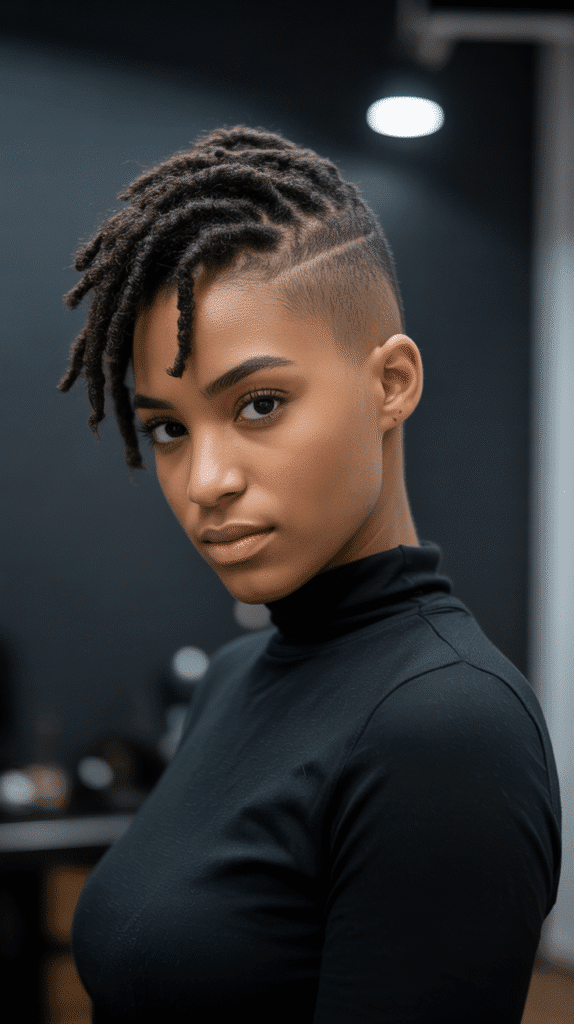
Starter locs combined with a tapered fade create a clean, modern foundation for your dreadlock journey.
This style works exceptionally well for those beginning their loc experience while maintaining a polished appearance.
- The tapered fade on the sides and back provides sharp contrast against the developing locs on top.
- This combination allows for a professional look during the awkward beginning stages of loc formation.
- Starter locs typically range from 2-4 inches in length and can be created using various methods including two-strand twists, comb coils, or interlocking.
- The fade can be customized from low to high depending on your preference and workplace requirements.
- Regular maintenance every 2-3 weeks keeps the fade fresh while your locs mature naturally.
- This style suits all face shapes and is particularly flattering for those with oval or square facial structures.
2. Two-Strand Twist Starter Locs
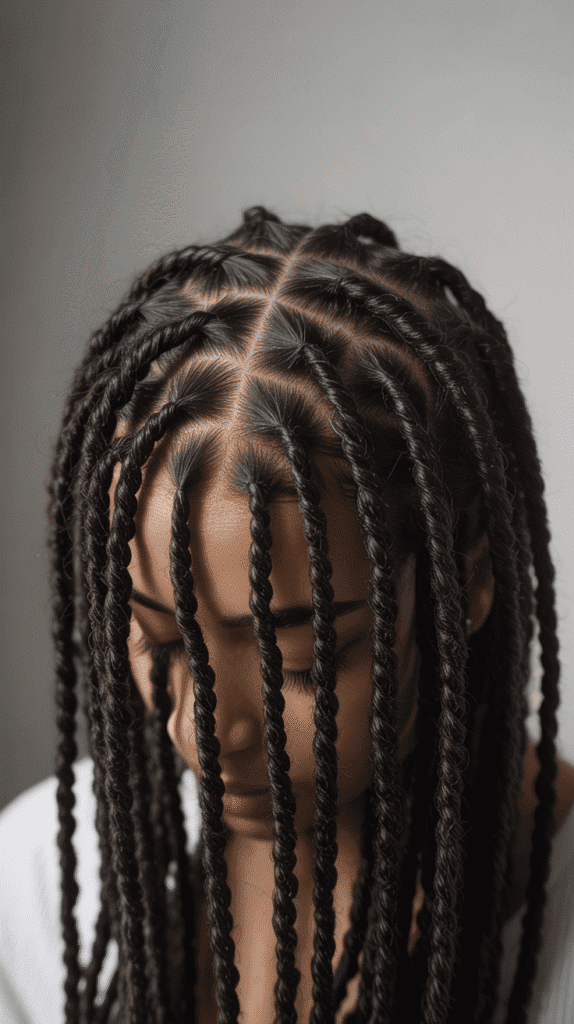
Two-strand twist starter locs offer a defined, rope-like appearance that serves as an excellent foundation for permanent dreadlocks.
This method creates uniform locs with consistent thickness throughout.
- Each section of hair is divided into two strands and twisted together from root to tip.
- This technique works exceptionally well for hair lengths between 2-6 inches.
- Two-strand twists provide a neater appearance during the initial loc formation compared to freeform methods.
- The style can be worn as-is while the locs mature, offering versatility during the starter phase.
- Maintenance involves re-twisting the roots every 4-6 weeks to encourage proper loc development.
- This method is gentle on the hair and scalp, making it ideal for those with sensitive skin.
- The twists naturally unravel into well-formed locs over time, typically within 6-12 months.
3. Freeform Short Locs
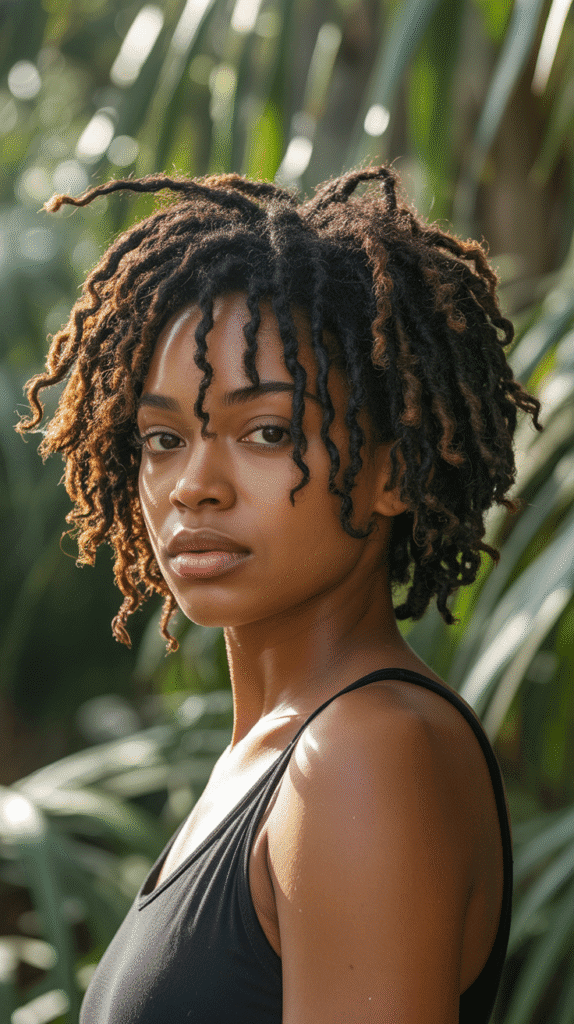
Freeform short locs embrace the natural locking process without manipulation or patterned sectioning.
This organic approach creates a unique, individualized look that develops authentically over time.
- The hair is allowed to loc naturally through washing and minimal interference.
- Each loc forms its own shape, size, and direction, creating a one-of-a-kind pattern.
- This method requires patience as locs may take 6-18 months to fully mature.
- Freeform locs work best with hair that’s at least 3-4 inches long.
- The style requires less maintenance than structured methods, focusing primarily on cleansing.
- Regular separation of locs prevents them from joining together into larger congos.
- This approach honors traditional African hair-locking practices and cultural heritage.
4. Micro Locs on Short Hair
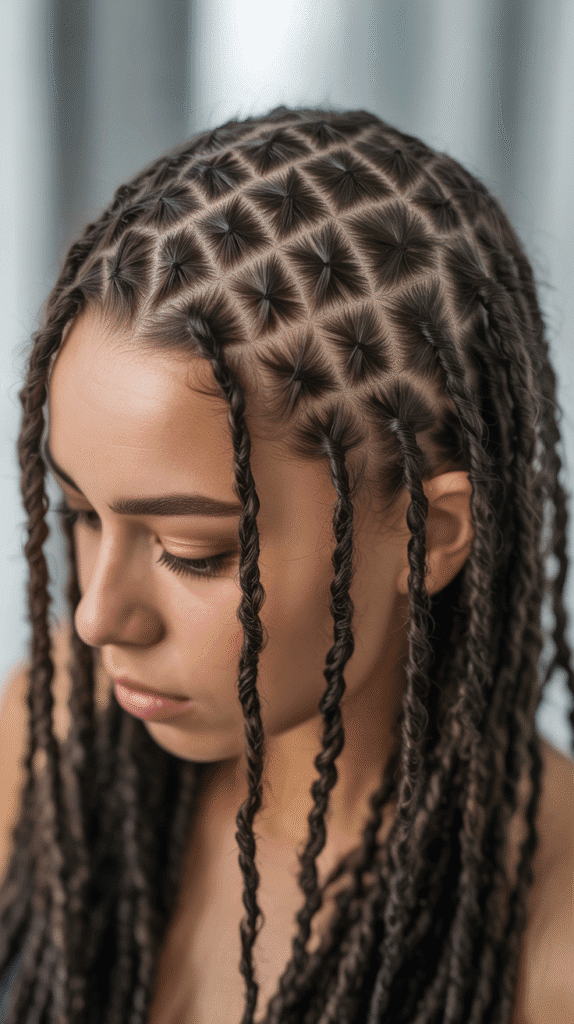
Micro locs feature extremely thin, pencil-sized dreadlocks that create a fuller appearance and offer exceptional styling versatility.
This precise technique works beautifully on shorter hair lengths.
- Individual locs measure approximately the diameter of a pencil or smaller.
- This method requires 400-600+ locs, creating incredible density and volume.
- Installation can take 24-48 hours depending on hair length and density.
- Micro locs can be styled in numerous ways despite their small size.
- The technique works well for those experiencing thinning hair or wanting maximum coverage.
- Maintenance requires re-tightening every 4-6 weeks using interlocking or palm rolling methods.
- This style provides a neater, more refined appearance compared to traditional-sized locs.
5. High Top Locs
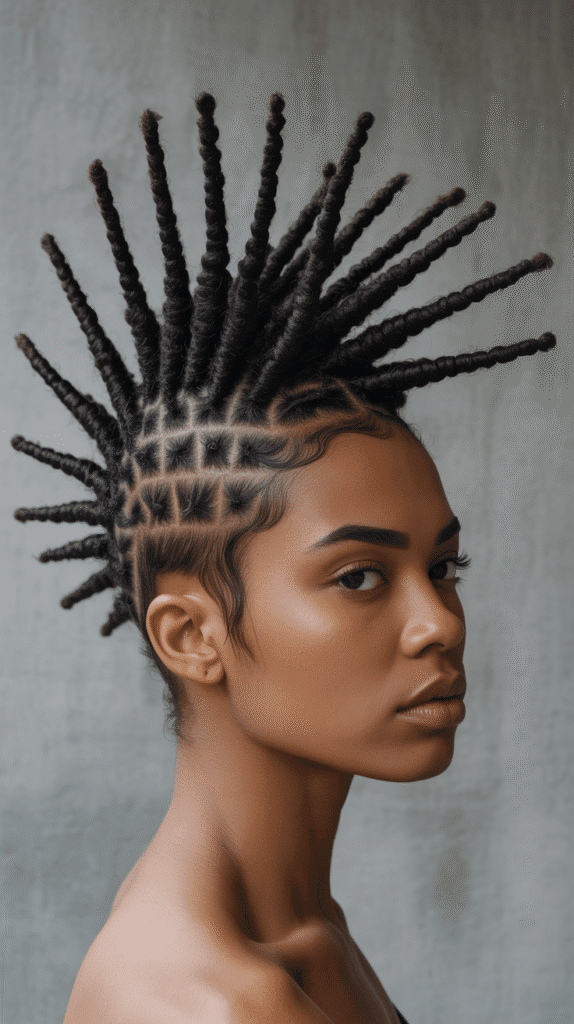
High top locs recreate the iconic 90s flat-top silhouette using dreadlocks instead of an afro.
This bold style combines retro aesthetics with modern loc culture.
- The sides and back are shaved or faded extremely short while the top maintains 3-6 inches of length.
- Locs on top stand upright, creating a distinctive rectangular or square shape.
- This style requires strong, well-established locs that can support vertical positioning.
- Regular shaping and trimming maintain the geometric flat-top appearance.
- The dramatic contrast between shaved sides and textured top creates maximum visual impact.
- This look works best for those with naturally thick, coarse hair that locks firmly.
- Styling products like loc gel or aloe vera help maintain the upright positioning.
6. Colored Short Locs
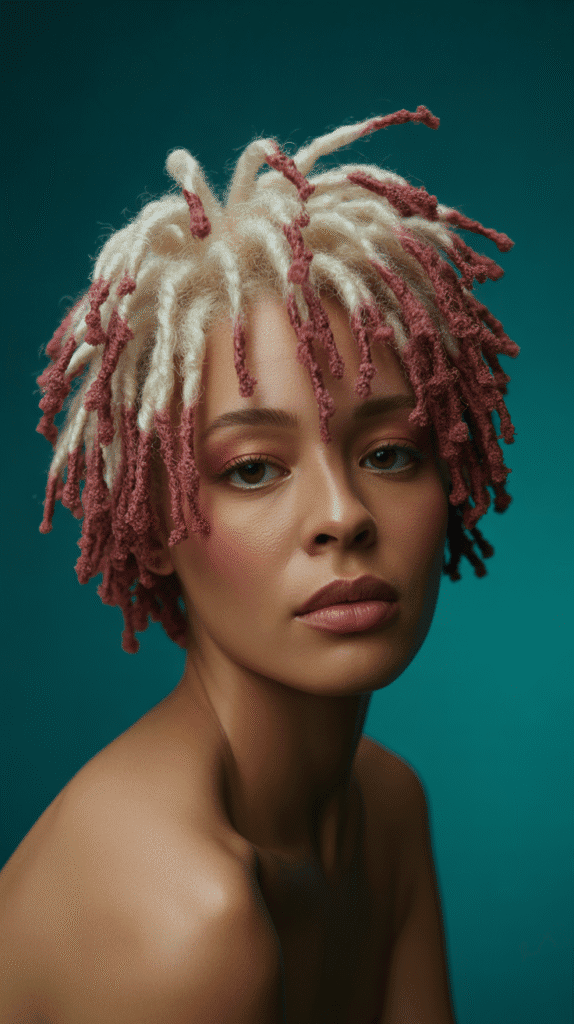
Adding color to short dreadlocks transforms them into vibrant statements of personal style.
Color application on shorter locs requires less maintenance and shows off hues brilliantly.
- Popular colors include platinum blonde, burgundy, copper, and fashion shades like blue or purple.
- Shorter length means less damage from chemical processes and easier color maintenance.
- Bleaching may be required for lighter or brighter colors, especially on naturally dark hair.
- Semi-permanent dyes offer less damaging alternatives for temporary color experimentation.
- Color should be applied to mature locs to prevent weakening during the formation stage.
- Regular deep conditioning treatments maintain hair health when using permanent color.
- Ombre or two-tone effects create dimension and visual interest on short locs.
7. Sponge Curl Starter Locs
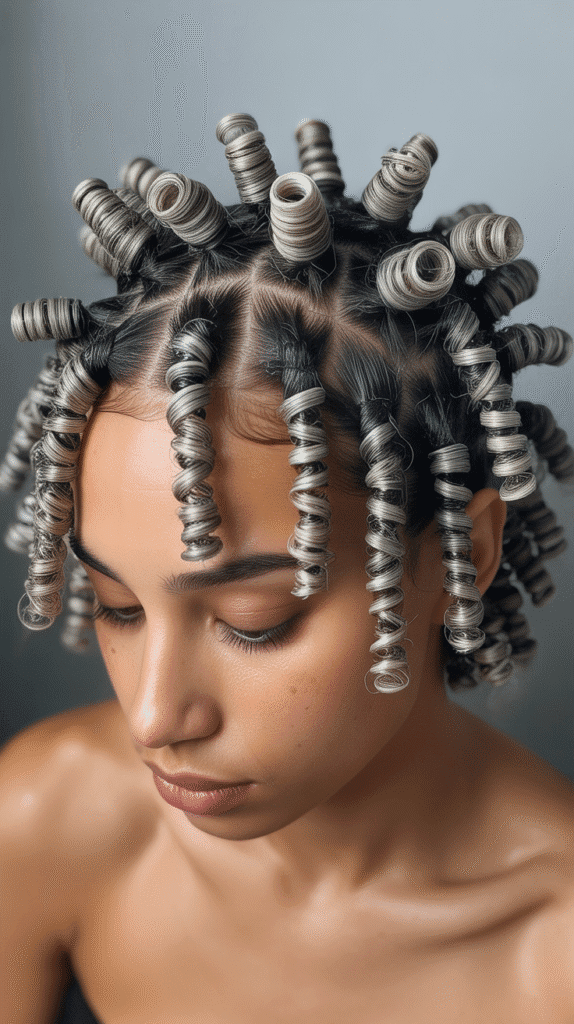
The sponge method creates coiled starter locs quickly and easily, making it one of the most popular techniques for beginning short locs.
This approach uses a specialized hair sponge with holes or grooves.
- A loc sponge is rubbed in circular motions across the hair to create uniform coils.
- This method works best on hair that’s 1-3 inches long.
- The technique produces dozens of small, spring-like coils that develop into locs over time.
- Results appear immediately, making it ideal for those wanting instant definition.
- The sponge method is cost-effective and can be done at home without professional help.
- Regular sponging sessions every few days help maintain coil definition during the starter phase.
- Once locs begin maturing, traditional maintenance methods replace the sponge technique.
8. Interlocked Short Locs
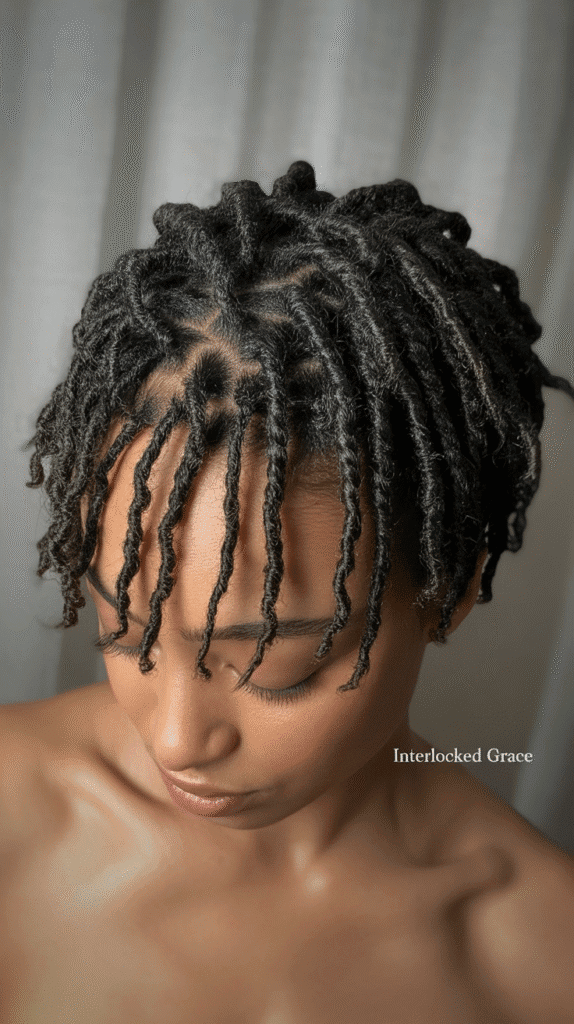
Interlocking creates tight, well-maintained locs by weaving the hair through itself using a specialized tool.
This method produces exceptionally neat results on short hair.
- A latch hook or interlocking tool pulls the loc end through the root in a specific pattern.
- This technique creates extremely tight, secure locs that resist unraveling.
- Interlocking works well on hair as short as 2 inches and all hair textures.
- The method produces a rope-like appearance with minimal frizz or loose hair.
- Maintenance appointments are needed every 4-8 weeks to interlock new growth.
- Four-point interlocking (up, down, left, right) creates the strongest lock pattern.
- This approach is particularly beneficial for those with fine or straight hair that doesn’t loc easily.
9. Temple Fade with Short Locs
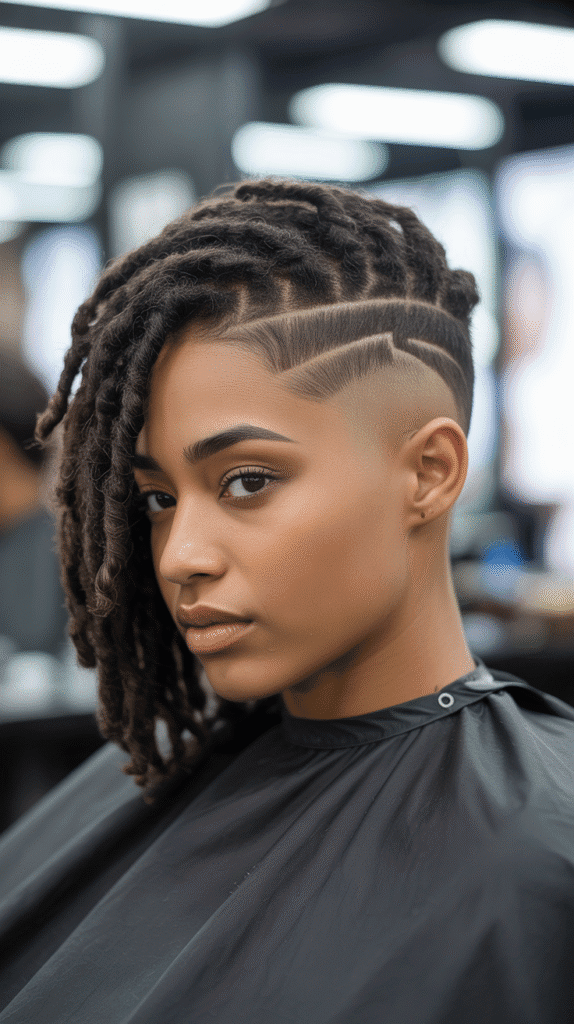
The temple fade features gradually shortened hair around the temples while maintaining longer locs on top.
This stylish cut emphasizes facial features and creates a contemporary silhouette.
- The fade begins at the temples and can extend around the perimeter of the hairline.
- This cut draws attention to the eyes and cheekbones, enhancing facial structure.
- Locs on top can be styled forward, backward, or left natural depending on preference.
- The fade requires regular maintenance every 2-3 weeks to maintain sharpness.
- This style bridges professional requirements with personal expression through locs.
- The gradual transition from skin to hair to locs creates sophisticated dimensionality.
- Temple fades work exceptionally well for those with receding hairlines or high foreheads.
10. Barrel Twist Locs
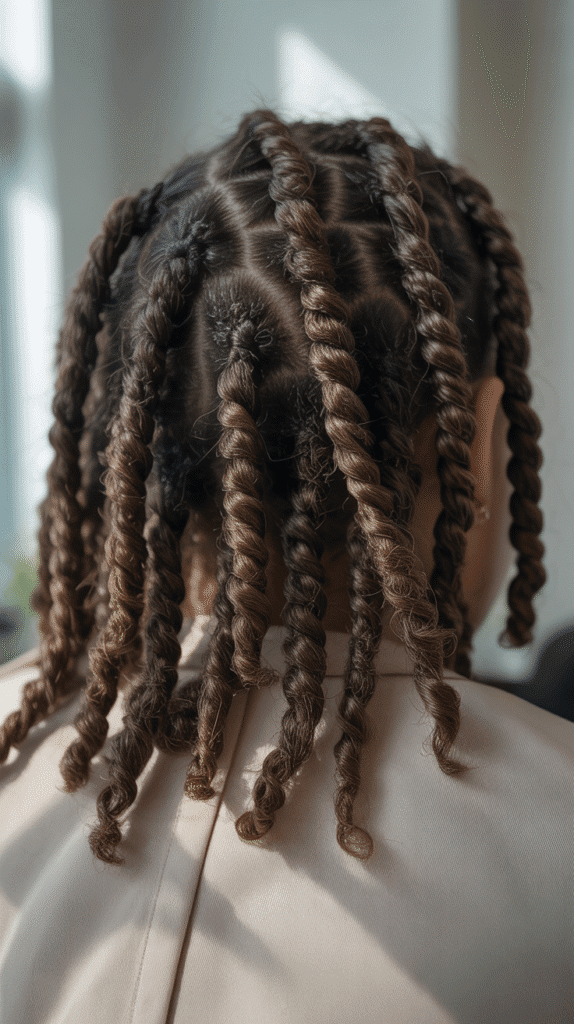
Barrel twists create chunky, defined locs with a distinctive twisted rope appearance.
This technique produces thicker locs than standard two-strand twists while maintaining structure.
- Two sections of hair are twisted around each other while simultaneously twisting each individual section.
- This double-twisting action creates a fuller, more textured appearance.
- Barrel twists work well on hair that’s 3-5 inches long.
- The style provides immediate definition while locs are forming underneath.
- Maintenance involves re-twisting roots every 4-6 weeks to encourage proper maturation.
- These twists create locs that are thicker and more substantial than standard starter methods.
- The technique is particularly flattering for those wanting fuller-looking dreads without waiting for maturity.
11. Geometric Parting Patterns
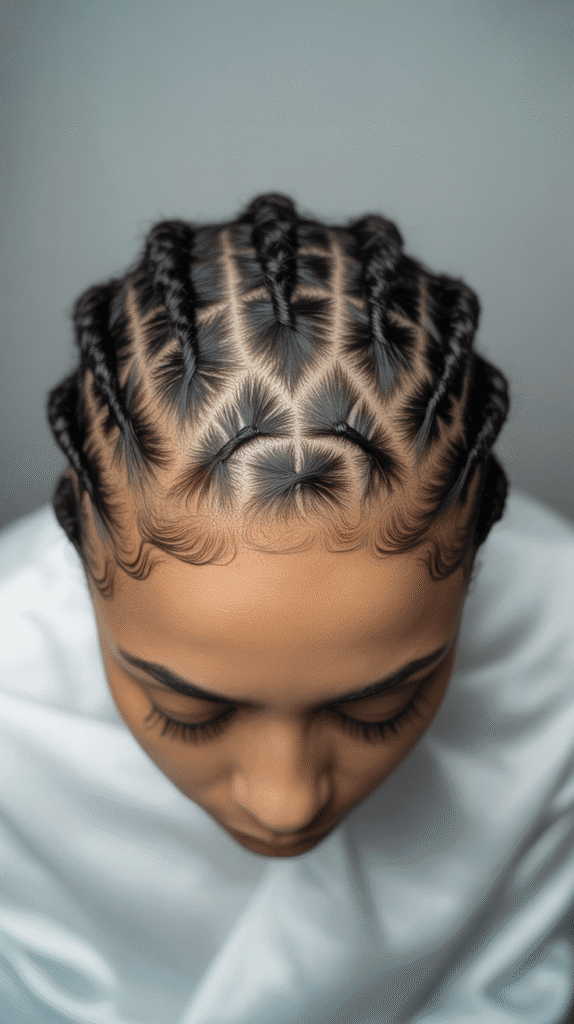
Creative parting patterns transform short locs into artistic expressions by organizing sections in geometric designs.
These patterns become more visible as locs mature and separate.
- Common patterns include triangular, diamond, brick-lay, and zigzag sectioning.
- The parting pattern is established during the initial loc installation and remains permanent.
- Geometric patterns add visual interest to the scalp and create organized, symmetrical appearance.
- This approach requires professional installation to ensure precise, even sections.
- Triangle parts are particularly popular as they allow locs to sit naturally in any direction.
- The pattern becomes a permanent feature of your loc style as the hair grows.
- Creative patterns showcase the intentionality and artistry of your loc journey.
12. Mohawk Locs
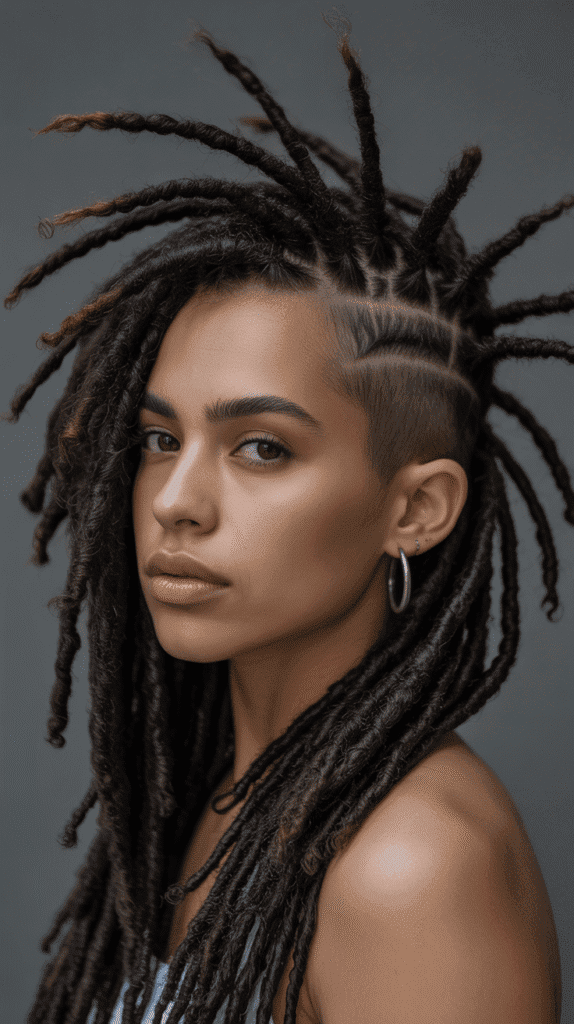
Mohawk locs feature shaved or faded sides with a strip of dreadlocks running from the forehead to the nape.
This edgy style makes a powerful fashion statement with short hair.
- The center strip of locs typically measures 2-4 inches wide.
- Sides can be completely shaved, faded, or maintained at a very short length.
- Locs in the mohawk section can stand upright or lay naturally depending on length and styling.
- This style requires regular maintenance on the shaved portions every 1-2 weeks.
- The mohawk creates dramatic contrast and draws attention to the central loc section.
- This look works for all genders and can be styled professionally or edgily depending on context.
- The width of the mohawk strip can be customized to suit face shape and personal preference.
13. Loc Bun (Top Knot)
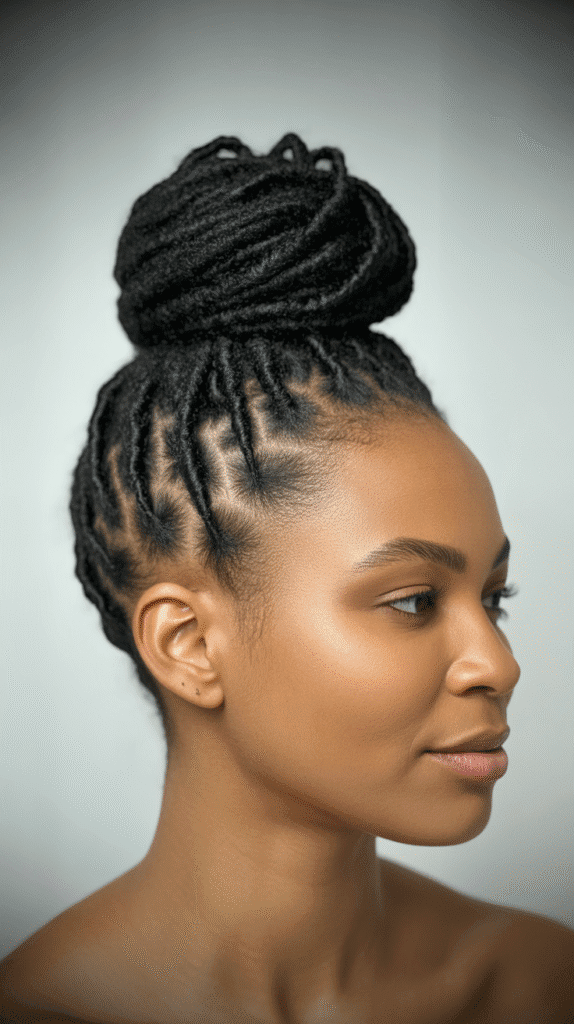
A loc bun or top knot gathers short dreadlocs at the crown of the head, creating a compact, elevated style.
This versatile look works for casual and professional settings.
- Short locs of 3-6 inches can be gathered into a small bun or knot.
- The style keeps locs off the face and neck, making it practical for active lifestyles.
- A loc-friendly elastic band or hair tie secures the bun without causing breakage.
- Sides can be left down, slicked back, or faded to complement the top knot.
- This style works particularly well for those in the awkward middle stages of loc growth.
- The bun can be positioned at various heights from low nape to high crown.
- Loose locs around the perimeter can be twisted or left free for added texture.
14. Comb Coil Starter Locs
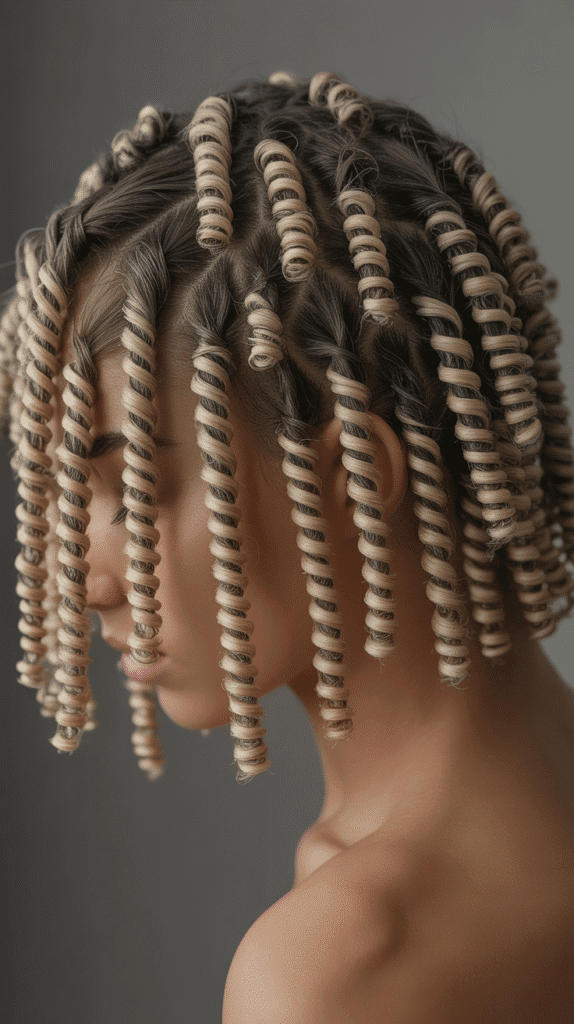
Comb coils create tight, spring-like starter locs using a small-toothed comb to twist hair into defined spirals.
This method produces uniform, cylindrical locs from the beginning.
- A rat-tail comb is used to twist small sections of hair into tight coils.
- This technique works best on hair that’s 1.5-4 inches long.
- Comb coils create immediate definition and structure for new locs.
- The method produces dozens to hundreds of small, uniform coils depending on desired loc size.
- Initial coils may unravel slightly but re-coil tighter with each maintenance session.
- This approach works well for all hair textures but shows particularly beautiful results on kinky-coily hair.
- Regular re-coiling every 4-6 weeks maintains the spiral pattern as locs mature.
15. Asymmetrical Short Locs
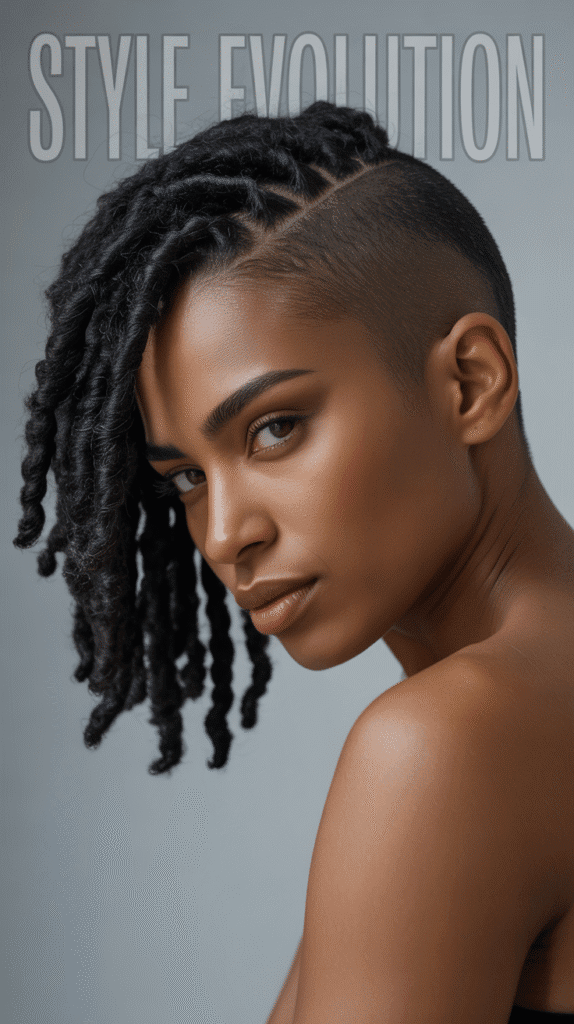
Asymmetrical loc styles feature uneven length distribution, with one side longer or styled differently than the other.
This modern approach adds avant-garde appeal to short dreadlocks.
- One side may be shaved or faded while the other maintains full loc length.
- Locs can be swept dramatically to one side for maximum asymmetrical effect.
- The style creates visual interest through intentional imbalance and unexpected proportions.
- This look suits those with strong personal style and confidence to wear bold cuts.
- The asymmetry can be subtle or dramatic depending on personal preference.
- Regular maintenance keeps the distinction between sides clear and intentional.
- This style photographs exceptionally well and creates memorable first impressions.
16. Blonde Short Locs with Dark Roots
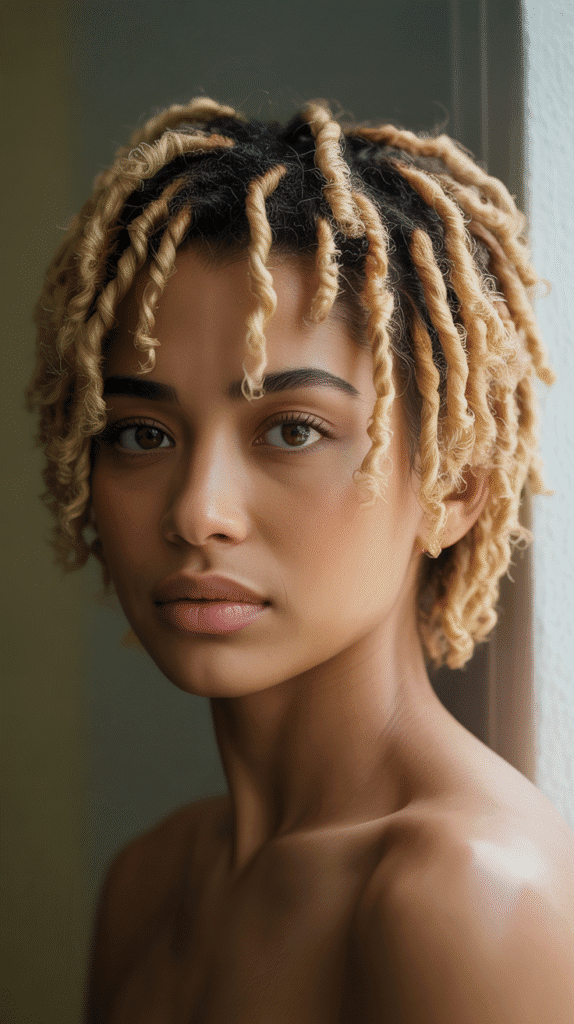
The dark root blonde look creates dimensional contrast on short locs, combining natural root color with bleached lengths.
This low-maintenance color technique adds depth and visual interest.
- Natural dark roots extend 1-2 inches before transitioning to blonde lengths.
- This style requires less frequent touch-ups than all-over blonde coloring.
- The contrast creates a shadow root effect that enhances texture and definition.
- Bleaching shorter locs causes less overall damage than processing longer hair.
- Deep conditioning treatments maintain hair health at the color-treated portions.
- The look works with various blonde shades from honey to platinum.
- This color approach suits all skin tones and can be customized for warmth or coolness.
17. Sisterlocks on Short Hair
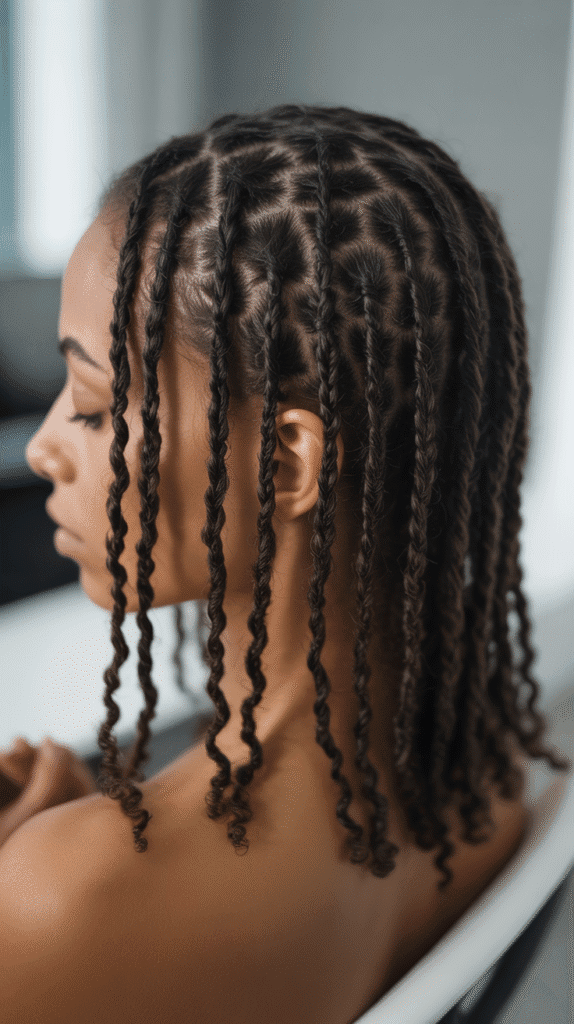
Sisterlocks are precision micro locs created with a specialized technique and tool, resulting in extremely small, uniform locs.
This method works beautifully on short hair and creates a refined appearance.
- Individual locs are approximately the size of a pencil lead or smaller.
- Installation must be performed by a certified Sisterlock consultant.
- The technique requires no products or twisting, relying purely on the interlocking method.
- Sisterlocks can number from 400 to 800+ depending on hair density.
- This style offers incredible versatility despite the small loc size.
- Maintenance appointments every 4-6 weeks involve retightening new growth.
- The refined appearance makes this style popular for professional environments.
18. Loc Curls with Perm Rods
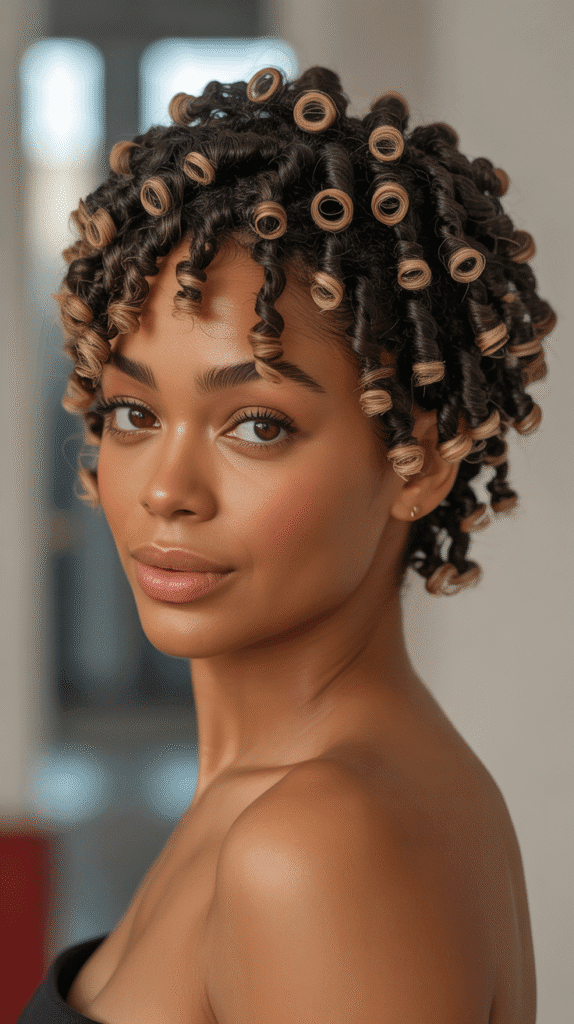
Perm rods create beautiful curls and waves on short locs, adding movement and texture.
This styling technique transforms straight or mature locs into bouncy, curled creations.
- Various sized perm rods are rolled onto damp locs and allowed to dry completely.
- The technique works best on locs that are at least 3 inches long.
- Sitting under a hooded dryer or air-drying overnight sets the curls.
- The resulting curls add volume and feminine appeal to short loc styles.
- Curl patterns can be customized using different rod sizes for varied textures.
- The style typically lasts 1-2 weeks before locs return to their natural state.
- This temporary styling option allows for versatility without permanent changes.
19. Line-Up with Short Locs
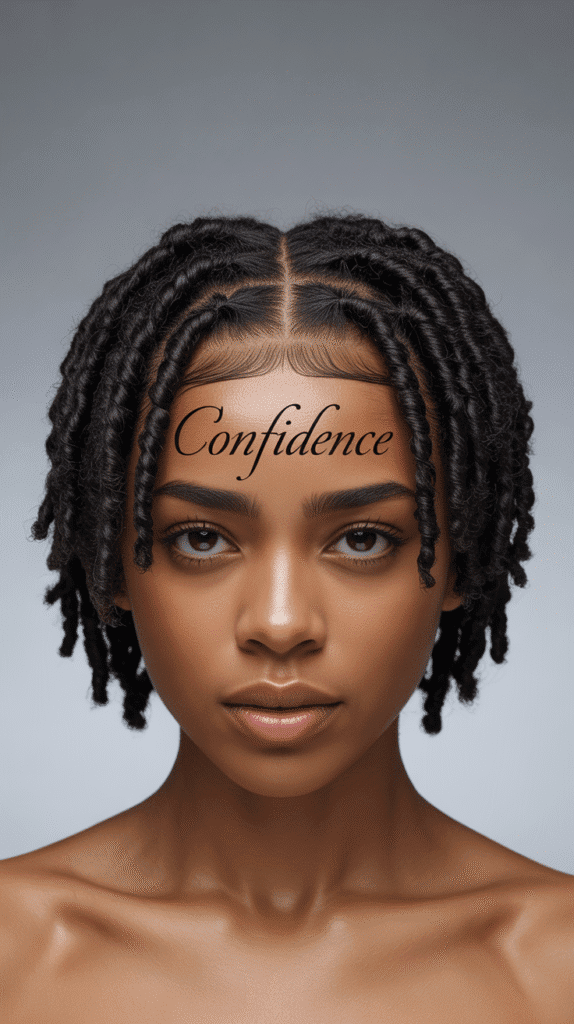
A sharp line-up or edge-up defines the hairline with precise edges, creating clean borders around short locs.
This detail-oriented grooming elevates the overall appearance.
- The hairline is shaped with straight, defined edges using clippers or razors.
- Common areas for line-ups include the forehead, temples, and nape.
- This grooming technique creates a polished, intentional appearance.
- Line-ups require maintenance every 1-2 weeks to maintain sharpness.
- The clean edges contrast beautifully with the natural texture of locs.
- Professional barbers can create custom line patterns for added personalization.
- This detail particularly enhances styles with fades or short sides.
20. Side-Swept Short Locs
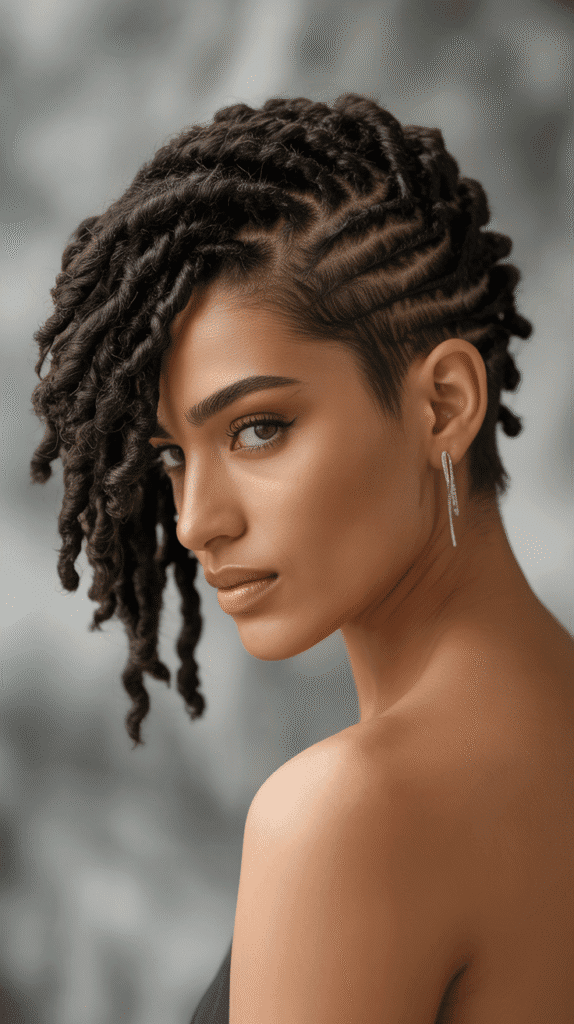
Side-swept short locs are styled dramatically to one side, creating an elegant, fashion-forward silhouette.
This styling approach works well for special occasions or everyday glamour.
- Locs are brushed or positioned to one side and can be secured with pins or ties.
- The style works best with locs that are 4-6 inches long.
- One side of the head appears fuller while the other shows more scalp.
- This look can be combined with shaved sides for maximum dramatic effect.
- The swept direction can alternate based on mood or outfit.
- Loc gel or aloe vera helps maintain the swept position throughout the day.
- This styling approach flatters most face shapes by creating diagonal lines.
21. Colored Tips on Short Locs
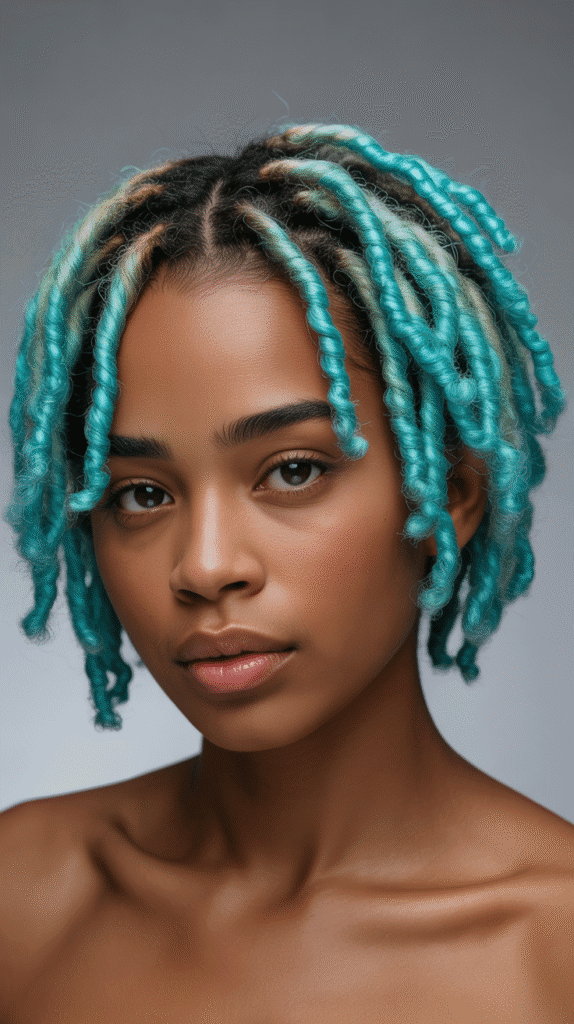
Colored tips or dip-dye effects add playful pops of color to the ends of short locs.
This technique provides color interest without full commitment to all-over coloring.
- Only the bottom inch or two of each loc is colored, leaving roots natural.
- Popular tip colors include red, blue, purple, pink, or metallic shades.
- This approach requires less bleaching and causes minimal overall hair damage.
- The color can be changed or removed more easily than all-over coloring.
- Shorter locs showcase tip colors prominently since the colored portion is more visible.
- Semi-permanent dyes work well for this technique and fade gradually.
- Multiple colors can be used simultaneously for rainbow or ombre effects.
22. Loc Braids (Braided Locs)
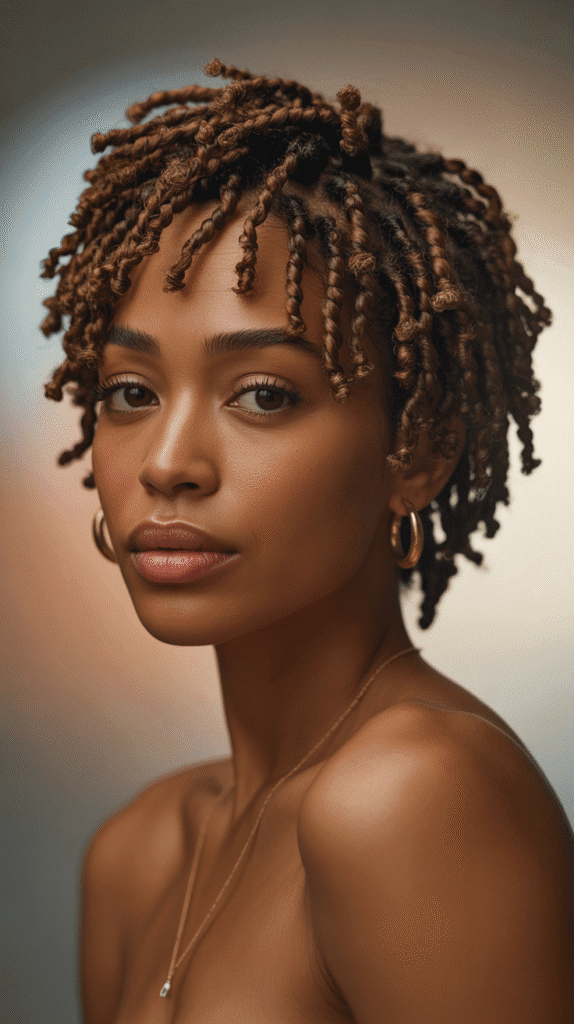
Individual locs can be braided together to create intricate patterns and styles.
This technique adds complexity and visual interest to short dreadlocks.
- Two or more locs are braided together using traditional three-strand braiding.
- This works best with locs that are at least 4 inches long.
- Braiding locs creates temporary styles without disturbing the loc structure.
- Common patterns include cornrows using locs instead of loose hair.
- The style can last several days to weeks depending on maintenance.
- Braided locs create dimension and texture variation across the head.
- This technique is gentler than braiding loose hair since locs are already established.
23. Undercut with Crown Locs
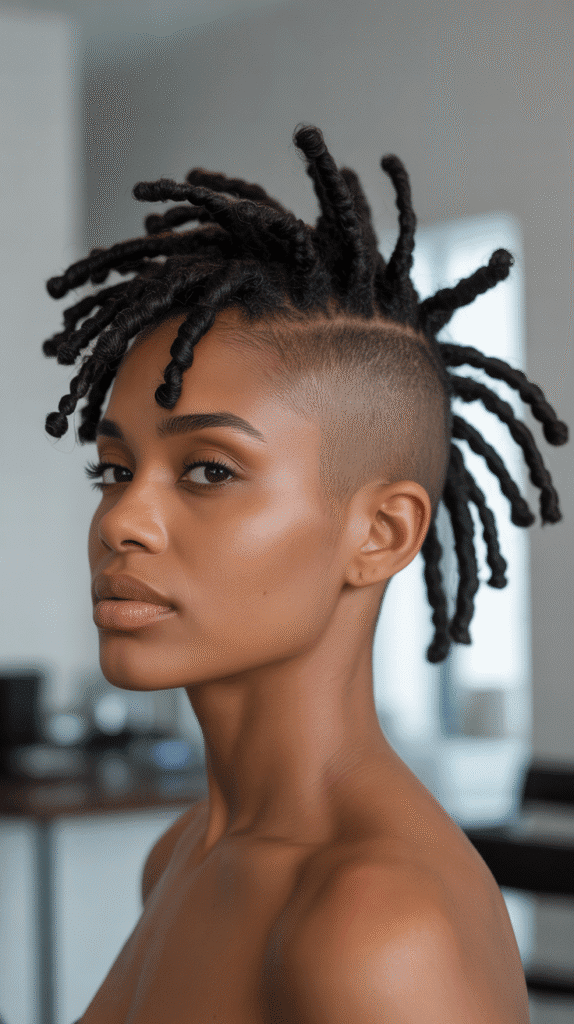
An undercut features closely shaved or buzzed hair underneath while maintaining longer locs on the crown and top.
This creates dramatic contrast and modern edge.
- The undercut area typically includes the sides and back below a defined line.
- Locs on top can be any length from 2-6 inches while undercut remains very short.
- This style offers cooling benefits by removing bulk underneath.
- The undercut is hidden when locs are down but revealed when gathered up.
- Regular maintenance every 2-4 weeks keeps the undercut fresh.
- This style is popular across all genders and age groups.
- The contrast between shaved sections and textured locs creates striking visual impact.
24. Natural Short Locs with Beads
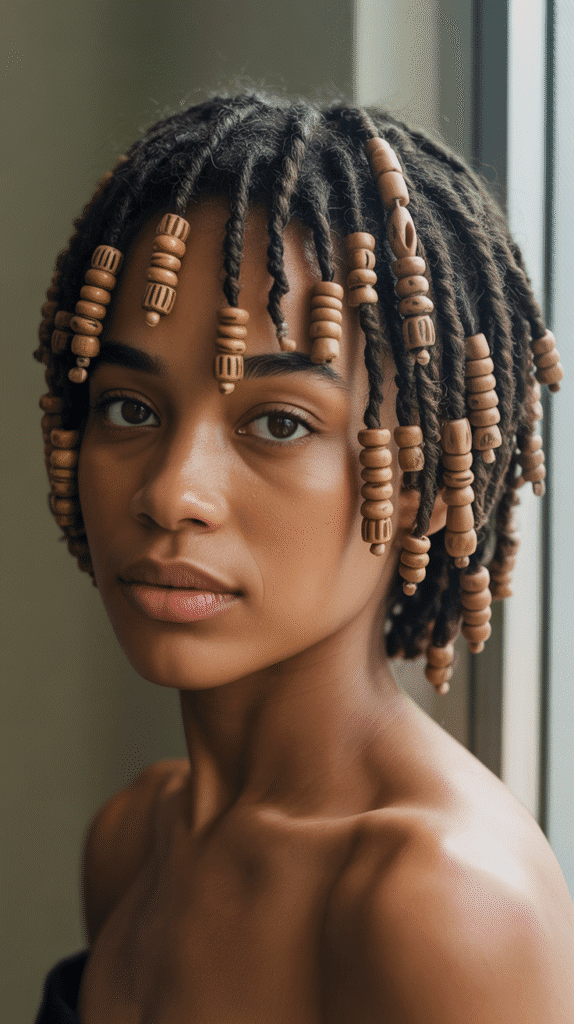
Adding beads to short locs incorporates cultural tradition and personal decoration.
Wooden, metal, or plastic beads slide onto individual locs for customizable adornment.
- Beads can be placed at various positions: ends, mid-shaft, or near roots.
- This decoration is deeply rooted in African and Caribbean cultural traditions.
- Beads add weight that can help locs hang differently or create movement.
- Various materials include wood, metal, clay, plastic, or glass beads.
- The decoration is temporary and can be added or removed without damage.
- Beads can be color-coordinated with outfits or represent personal meanings.
- Multiple beads on single locs create stacked effects and musical tinkling sounds.
25. Twisted Short Locs
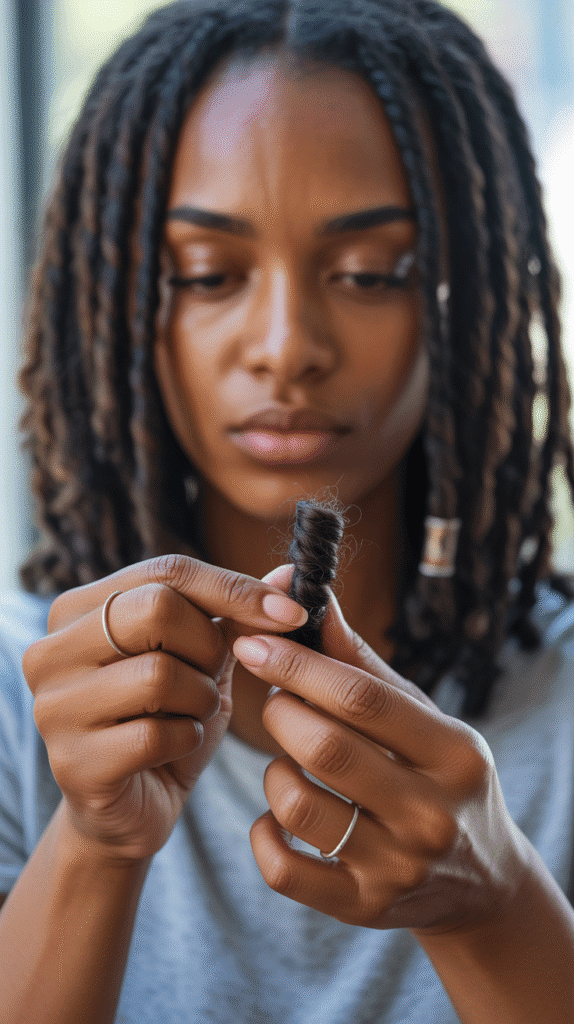
Palm rolling or twisting individual locs maintains their cylindrical shape and neat appearance.
This maintenance technique is essential for well-groomed short dreadlocks.
- Each loc is rolled between the palms to smooth frizz and maintain roundness.
- This technique is typically performed during maintenance appointments every 4-6 weeks.
- Palm rolling encourages locs to maintain consistent diameter from root to tip.
- The process can be done on damp or dry locs depending on method.
- Aloe vera gel or loc cream can be used to facilitate smooth rolling.
- Regular palm rolling prevents locs from becoming flat or misshapen.
- This maintenance approach works for all loc sizes and hair textures.
26. Loc Accessories and Wraps
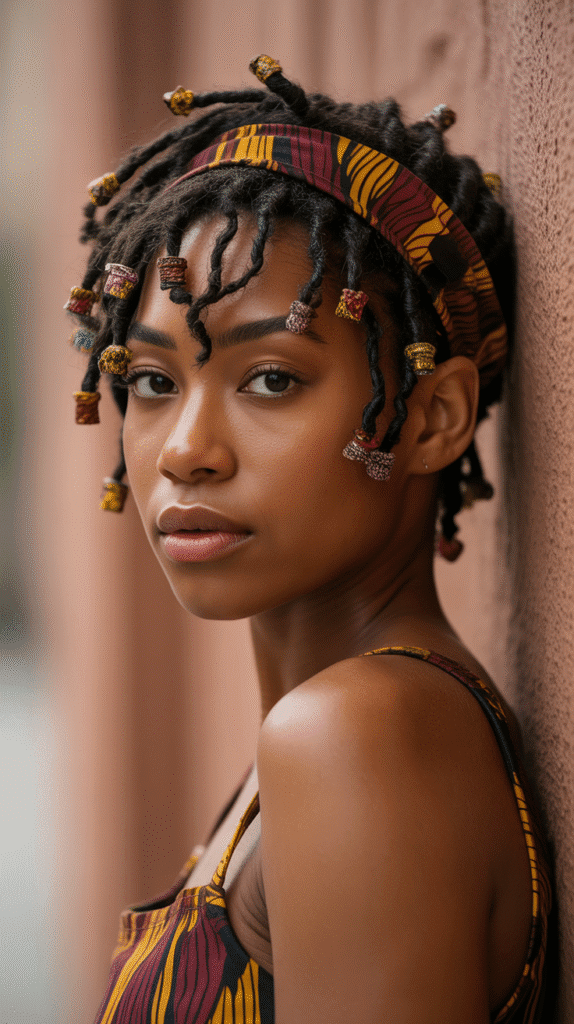
Fabric wraps, headbands, and accessories add style and protect short locs.
These additions provide endless variety without changing the locs themselves.
- Fabric wraps can be made from African prints, silk scarves, or cotton materials.
- Headbands frame the face and keep shorter locs in place.
- Loc jewelry including cuffs, rings, and decorative pins adds personal flair.
- These accessories protect locs from environmental damage and friction.
- Wraps can be styled in numerous ways from turbans to half-wraps.
- Accessories allow daily style changes without manipulating the locs themselves.
- Cultural and fashion accessories celebrate both heritage and contemporary style.
27. Bleached Short Locs
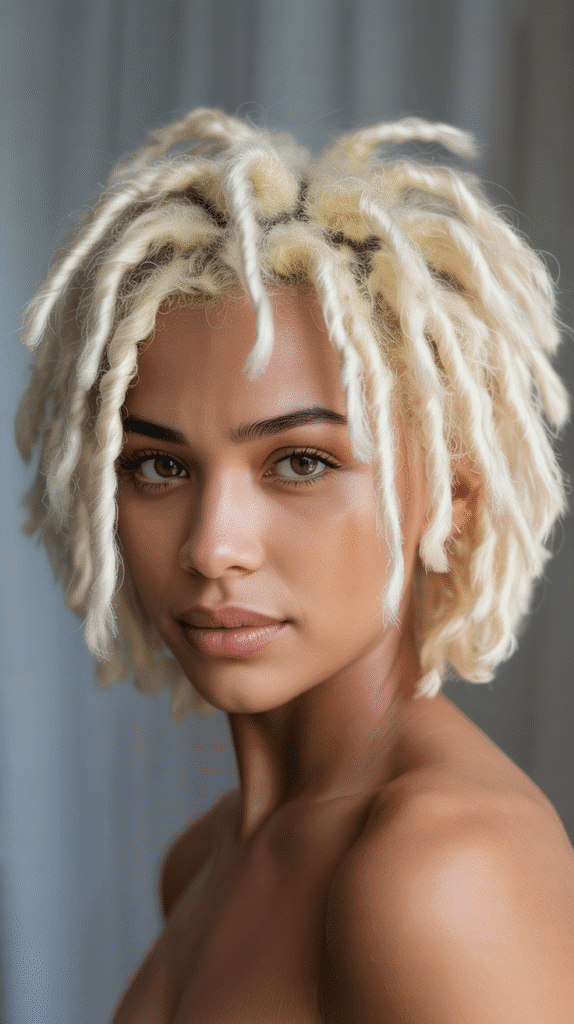
Full bleaching creates dramatic platinum or light blonde short locs that make bold fashion statements.
This transformative coloring requires professional application and dedicated maintenance.
- Bleaching lifts natural pigment to achieve light blonde or white shades.
- The process works best on mature locs that are fully locked and strong.
- Multiple bleaching sessions may be required for darker hair to reach desired lightness.
- Deep conditioning treatments are essential after bleaching to restore moisture.
- Bleached locs require purple toning shampoo to prevent brassy yellow tones.
- Shorter length means less damaged hair to manage compared to long bleached locs.
- The dramatic transformation creates striking contrast against all skin tones.
28. Loc Frohawk
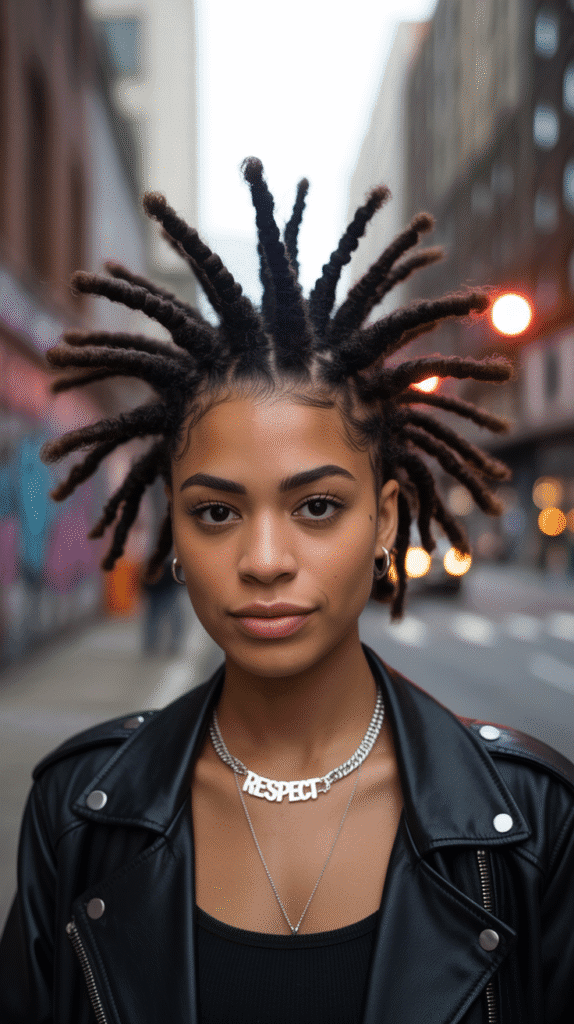
A frohawk or faux-hawk features locs styled upward in a central strip while sides are smoothed down or shaved.
This style combines punk aesthetics with loc culture.
- Central locs stand upright creating a mohawk-like silhouette without shaving.
- Sides can be slicked down with gel or shaved for more dramatic effect.
- The style works with locs as short as 3 inches.
- Styling products help locs maintain upright positioning throughout the day.
- This look bridges edgy and professional depending on execution.
- The frohawk can be styled casually or sculpted precisely for special occasions.
- This versatile style works for all genders and can be adapted for various settings.
29. Short Locs with Fade Design
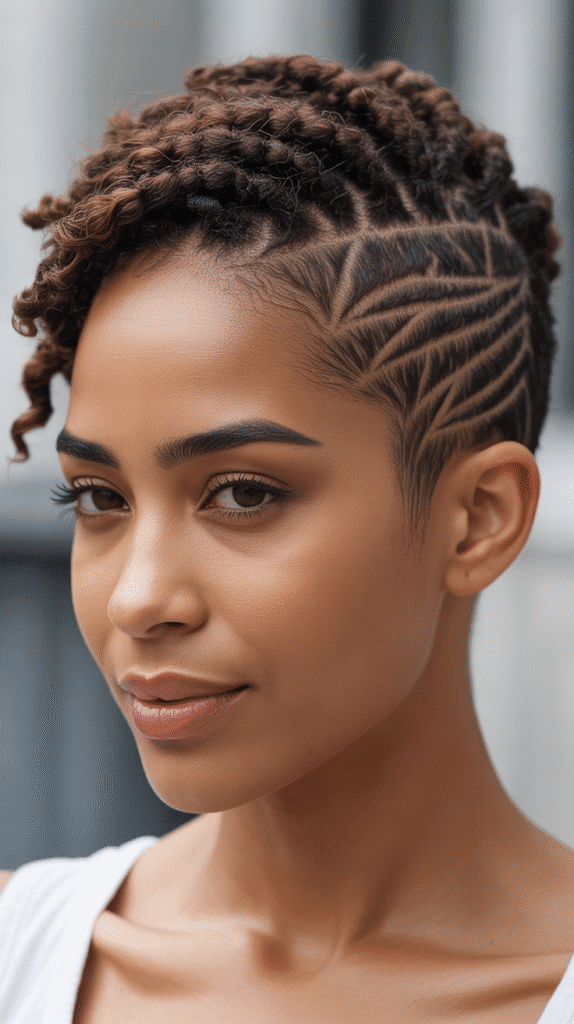
Fade designs incorporate artistic patterns shaved into faded sides while locs remain on top.
These custom designs showcase personal creativity and skilled barbering.
- Common designs include lines, geometric shapes, symbols, or custom artwork.
- The design is shaved into the fade using clippers and precision tools.
- Designs require touch-ups every 1-2 weeks as hair grows.
- This combination of loc texture and shaved art creates unique personal expression.
- Popular design elements include tribal patterns, waves, or symbolic images.
- Professional barbers can create custom designs based on personal requests.
- The contrast between textured locs and smooth designs creates visual interest.
30. Natural Mature Short Locs
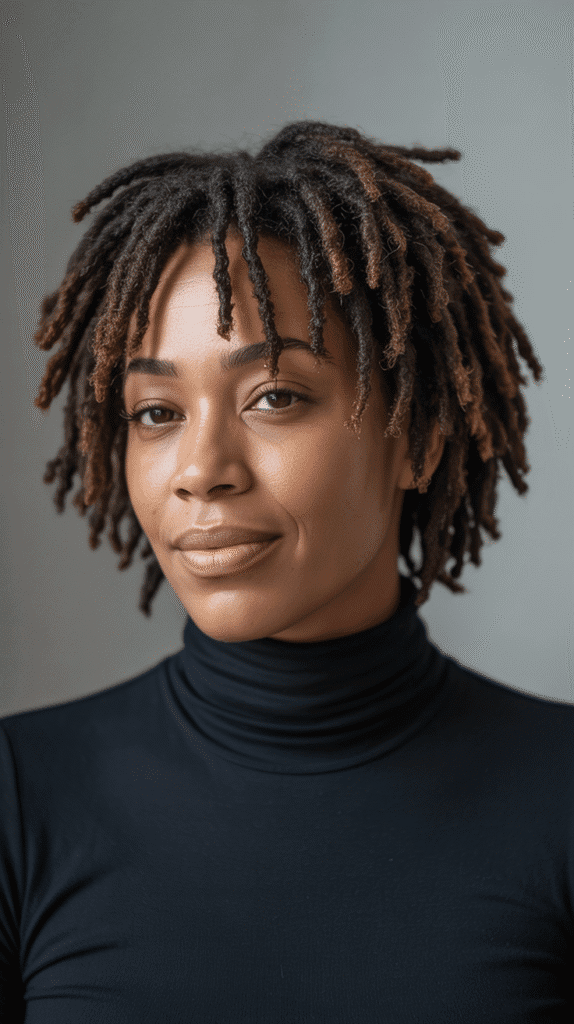
Well-maintained natural mature short locs showcase the beauty of established dreadlocks at shorter lengths.
These locs have completed the maturation process and display full texture and character.
- Mature locs are fully locked from root to tip with solid cylindrical structure.
- These locs typically have passed the 12-month mark and show consistent texture.
- Natural coloring and organic growth patterns create authentic appearance.
- Maintenance focuses on root tightening and keeping locs separated.
- Mature short locs offer the easiest styling and care routine.
- The established structure means locs hold their shape reliably.
- This represents the fully realized potential of the loc journey at shorter length.
Maintenance Tips for Short Dreadlocks
Basic Care Routine
Proper maintenance keeps short locs healthy, neat, and attractive throughout their development.
- Wash locs every 1-2 weeks using residue-free shampoo to prevent buildup.
- Deep condition monthly to maintain moisture balance and prevent brittleness.
- Retwist or maintain roots every 4-8 weeks depending on hair growth rate.
- Sleep with a satin or silk scarf to reduce frizz and protect locs.
- Avoid heavy products that cause buildup in shorter locs.
- Keep locs separated to prevent unwanted joining or congo formation.
- Schedule regular professional maintenance for optimal appearance.
Styling Products for Short Locs
Selecting appropriate products enhances short loc appearance without causing damage or buildup.
- Lightweight loc gels provide hold for styling without heavy residue.
- Aloe vera gel offers natural hold and moisture benefits.
- Water-based products work better than oil-heavy alternatives for short locs.
- Avoid petroleum-based products that cause buildup and prevent locking.
- Natural oils like jojoba or sweet almond nourish without weighing down short locs.
- Residue-free shampoos specifically formulated for locs prevent white buildup.
- Loc-specific products designed for maintenance support healthy development.
For more information on proper loc maintenance, visit NaturallyCurly’s guide to dreadlock care.
Conclusion
The versatility of 30 Stylish Dreadlock Styles for Short Hair That Look Fresh proves that impressive dreadlocks don’t require extensive length.
From professional starter locs with tapered fades to bold colored tips and geometric patterns, short locs offer countless opportunities for self-expression and style innovation.
Whether you’re beginning your loc journey with comb coils and two-strand twists, or maintaining mature locs at a cropped length, these 30 styles demonstrate the creative possibilities available.
Short dreadlocks provide practical benefits including easier maintenance, faster drying time, and professional versatility while still celebrating the cultural significance and personal meaning of locs.
The key to success lies in choosing a style that reflects your personality, maintaining proper care routines, and working with experienced professionals when needed.
Embrace the fresh, contemporary appeal of short locs and discover how these compact styles deliver maximum impact with minimal length.
Your perfect short dreadlock style awaits among these inspiring options, ready to transform your look and boost your confidence.
